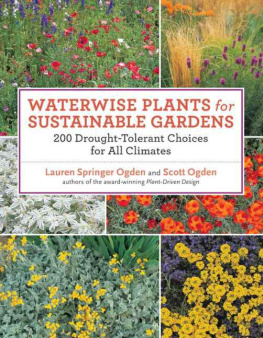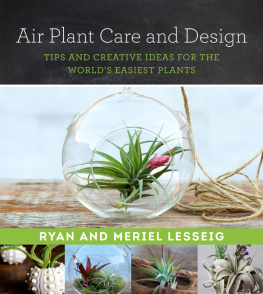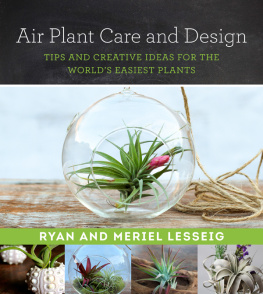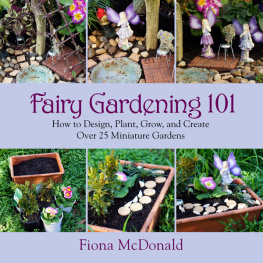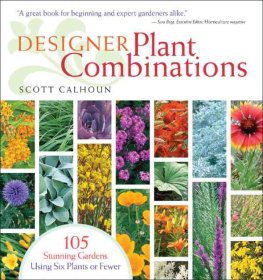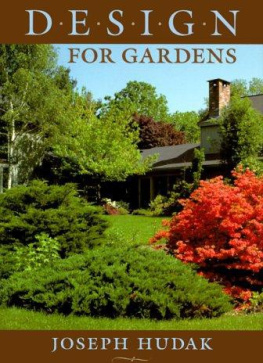PLANT-DRIVEN DESIGN
Creating gardens that honor plants, place, and spirit


PLANT-DRIVEN DESIGN
Creating gardens that honor plants, place, and spirit
Scott Ogden & Lauren Springer Ogden

FRONTISPIECE Tanacetum cinerariifolium, Stipa pennata, Oenothera macrocarpa, O. fremontii, Fallugia paradoxa, Nassella tenuissima, Sideritis scardica, Dianthus alpinus, Agastache rupestris, authors garden, Fort Collins, Colorado.
RIGHT A May meadow bursts forth in spring hues of pale yellow, white, and fresh green. Daffodils, Thermopsis lupinoides, Euphorbia epithymoides,
Malus sargentii Tina, Deschampsia caespitosa, authors garden, Fort Collins, Colorado.
OVERLEAF This free-spirited dryland garden, planted primarily in western natives, evokes the untamed feel of the region. Forestiera neomexicana, Pinus aristata, Eschscholzia californica, Nassella tenuissima, Penstemon spp., Phlox nana, Agastache rupestris, authors garden, Fort Collins, Colorado.
Copyright 2008 by Scott Ogden and Lauren Springer Ogden. All photographs by the authors. All rights reserved.
Published in 2008 by
Timber Press, Inc.
The Haseltine Building
133 S.W. Second Avenue, Suite 450
Portland, Oregon 97204-3527
www.timberpress.com
2 The Quadrant
135 Salusbury Road
London NW6 6RJ
www.timberpress.co.uk
Second printing 2009
Printed in China
Designed by Susan Applegate
Library of Congress Cataloging-in-Publication Data
Ogden, Scott.
Plant-driven design: creating gardens that honor plants, place, and spirit/by Scott Ogden and Lauren Springer Ogden.1st ed.
p. cm.
Includes index.
ISBN-13: 978-0-88192-877-8
1. GardensDesign. 2. Landscape design. 3. Plants, Ornamental. I. Ogden, Lauren Springer. II. Title. III. Title: Plant driven design. IV. Title: Creating gardens that honor plants, place, and spirit.
SB472.45.o33 2008
712dc22
2008002791
A catalog record for this book is also available from the British Library.


PREFACE
Gardens are for plants
Every plant has fitness and must be placed in its proper surroundings so as to bring out its full beauty. Therein lies the art of landscaping.
JENS JENSEN (18601951)
Danish-American landscape architect
THIS BOOK IS FOR lovers of plants, nature, and gardensin particular those who are inspired by this love to make wonderful gardens. The ideas and opinions filling the pages that follow arise from one premise: gardens exist because of gardeners, not designers. And yet this is a book about garden design. In it we aim to unite the often disparate roles of designer and gardener, and the work of creating and planting.
A troublesome gap exists between those who tend gardens and those who design them. Certainly some people do both these things with joy and ease, but most do not. Perhaps this results partly from natural tendencies: those who gravitate toward growing may have one set of innate preferences and abilities, and those who tend toward visual artistry, another. Mostly the schism seems to stem from a lack of confidence on the part of those who find themselves in an unfamiliar realm. So youll hear many exceptional gardeners and specialist growers protest that they cant design themselves out of a hole in the ground and see them show signs of serious intimidation when confronted by the process, with more self-deprecation forthcoming or even out-and-out refusal to try. Designers are often more circumspect about admitting their discomfort. Many simply avoid intimacy with plants or any depth of plantsmanship and rely instead on a limited, proven palette and series of plant combinations that they trot out like familiar dinner recipes, again and again.
True to its title, this book differs from other design books in that it begins with the assumption that plants come first, not style or architecture. What it is not is a cookbook for garden design. Youll find no simple how-to, no formulaic step-by-step, no hard-and-fast rules, no lofty principles. Instead youll meet with ideas, options, approaches, and plants from the world over. So, more specifically, this book is for gardeners who want the confidence to design, and designers who want the confidence to plant.
The single most essential element in any garden is not some particular object, plant, or tool. Whats vital is a gardener who loves it. Unfortunately, much of what is promoted as or called a garden in North America is nothing more than a landscape installation. Love has nothing to do with it. This sad reality is furthered by our cultures ever-shrinking attention span and ever-growing demand for material things. The garden has become a product, a home-improvement project, a look. No wonder home decor and plants often share space at retail outletstheyre being billed as one and the same. Statues, gazing globes, finials, and whatnot proliferate alongside plants. This is not to suggest that incorporating objects into the garden is a bad thing (though there ought to be some creativity, relevance, and personal expression in their selection and/or placement), but the implication that they should get equal billing with the plants is absurd.
OPPOSITE Echinacea pallida,
Monardafistulosa, Salvia
sclarea, Festuca mairei,
Koeleria macrantha,
authors garden, Fort
Collins, Colorado.
Gone, then, is the ongoing process and relationship gardeners seek and enjoy, as gardening becomes a goal-driven activity with the desired end product a garden that once installed should be maintained with a minimum of effort and involvement. How can a novice gardener learn from such a model? How can a designer create a real garden this way? Maintenance may occasionally be tedious, but most of the time its simply gardening, and thats what many of us love to do. The reality is, a person who dislikes gardening but wants to possess a garden will never have one that can honestly be called his or her own, no matter how much money or hired staff is thrown at it.
Maintenance also implies a static state for the garden. Plants and gardens change thanks to time, erratic weather, and peoples desires. Inherent change, lack of complete control, and the ongoing relationship between plant and gardener all give gardening a special allure that sets it apart from other passionate activities for those of us so smitten; otherwise we would spend that time rebuilding engines, painting faux finishes on walls, or embroidering chair seats. Plants are the element that sets gardening apart from other arts or crafts, which have no such relationship with anything alive. Making plants the main focus of design returns gardenmaking to being about a relationship between plants and people. That relationship should be a happy one. Why not invite plants into the garden not as surrogates for paint chips, curtains, carpets, or chairs, but rather as living beings that attract us, pique our curiosity, and encourage interaction?
Next page

